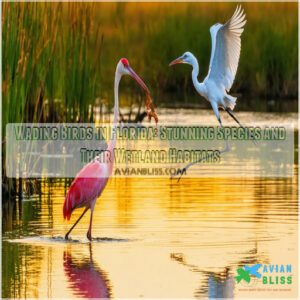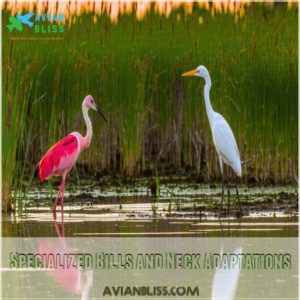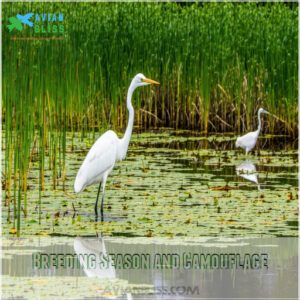This site is supported by our readers. We may earn a commission, at no cost to you, if you purchase through links.

You’ve got the majestic great blue heron, standing tall as it stalks fish in shallow waters.
The vibrant roseate spoonbill steals the show with its pink feathers and spoon-shaped bill, perfect for sifting tiny snacks.
White ibises use their curved bills to probe mud for crustaceans, while great egrets gracefully spear fish with their sharp beaks.
These birds rely on long legs and agile toes to navigate wetlands, which provide essential feeding, nesting, and roosting spots.
Protecting these habitats is key to keeping Florida’s wading birds thriving, and it is crucial for maintaining the delicate balance of the ecosystem.
Table Of Contents
- Key Takeaways
- Wading Bird Diversity in Florida
- Wading Bird Characteristics
- Importance of Wetlands for Wading Birds
- Threats to Wading Bird Survival
- Conservation Actions for Wading Birds
- Frequently Asked Questions (FAQs)
- What is the big wading bird in Florida?
- What is the big grey water bird in Florida?
- What is the difference between a heron and an egret in Florida?
- What Florida bird dives into water?
- How do wading birds attract mates?
- What are wading birds nesting habits?
- How long do wading birds live?
- What predators threaten wading bird populations?
- Are any wading birds invasive species?
- What laws protect wading birds in Florida?
- Conclusion
Key Takeaways
- You’ll spot incredible wading birds like great blue herons, roseate spoonbills, and white ibises thriving in Florida’s wetlands thanks to their specialized bills and legs.
- Wetlands are critical for feeding, breeding, roosting, and migration, supporting 17 unique wading bird species.
- Habitat loss, pollution, and climate change threaten these birds, making wetland conservation essential for their survival.
- Supporting conservation efforts, protecting wetlands, and spreading awareness help secure a future for wading birds in Florida.
Wading Bird Diversity in Florida
Florida’s wetlands are a hotspot for wading bird species, offering a front-row seat to their amazing diversity.
The great blue heron, standing like a silent hunter, thrives in shallow waters, while the green heron—a smaller, shyer counterpart—sticks close to home.
You’ll often see great egrets, their dazzling white feathers glowing against the wetlands, skillfully spearing fish.
Nearby, white ibises work in groups, their curved bills probing mud for crustaceans.
Then there’s the flamboyant roseate spoonbill, flaunting pink plumage and spoon-shaped bills, often found in mangrove-fringed lagoons.
Their courtship looks more like a fencing match than romance!
These essential wetlands provide essential habitat for at least 17 wading bird species, supporting their foraging, breeding, and roosting needs.
Each bird follows unique bird migration patterns and feeds in specialized habitats.
Exploring these wetlands unravels a living map of Florida birding and wading bird diversity.
Wading Bird Characteristics
You’ll recognize wading birds by their long legs, agile toes, and graceful necks, perfect for balancing in shallow water.
Their specialized bills and opportunistic feeding habits make them experts at thriving in Florida’s wetlands.
Long Legs and Agile Toes
Wading birds in Florida are built for life on the water, and their leg anatomy is a big reason why.
Those long legs act like stilts, keeping them steady in shallow ponds and wetlands.
But it’s their toe structure that seals the deal—like nature’s all-terrain gear, it gives them balance control over slippery mud.
These adaptive features make wading birds masters of wading techniques, thriving in Florida’s ever-changing wetlands.
Specialized Bills and Neck Adaptations
It’s not just their legs that wow you—wading birds work magic with their specialized bills and neck flexibility.
Every beak functions like a tool crafted for specific feeding techniques:
- Spoon-shaped bills help Roseate Spoonbills filter tiny snacks from shallow waters.
- Curved bills let ibises probe mud for hidden treats.
- Sharp, spear-like bills make herons ace at nabbing fish.
You can explore various wading bird beak types and their functions.
Their long, snake-like necks give them unmatched precision and speed when hunting.
These adaptive features make Florida wading birds unstoppable in their wetlands playground.
Breeding Season and Camouflage
When breeding season kicks in, Florida wading birds put on a show you won’t forget.
Plumage changes turn species like the great egret into eye-catching beauties with long, wispy plumes, and smaller birds, like the little blue heron, rely on clever camouflage techniques to blend perfectly into the wetlands.
Courtship rituals include dramatic displays and competitive nesting habits, where males work hard to impress, highlighting the unique wading bird characteristics in Florida’s wild habitats, which is influenced by the use of bird camouflage techniques.
The use of these techniques plays a pivotal role in the survival and success of these species during breeding season, making breeding season and wading bird characteristics crucial for their prosperity.
Importance of Wetlands for Wading Birds
Wetlands are essential for wading birds in Florida, providing the perfect spots for foraging, breeding, and roosting.
With 17 species relying on these habitats, wetlands play a vital role in their survival and conservation.
Foraging, Breeding, and Roosting
Florida’s wetlands are like bustling diners, nurseries, and hotels for wading birds.
These habitats support every aspect of their lives:
- Feeding Strategies: Think of herons stalking prey or ibises probing for insects. Each bird’s unique beak gets the job done.
- Nesting Habits: Nesting sites offer shelter and spots for chick-rearing.
- Roosting Behavior: Nights mean resting safely away from predators.
- Bird Migration: Wetlands act like pit stops during long journeys.
- Flock Dynamics: Sharing these spaces requires careful navigation and cooperation.
Florida boasts diverse water bird species, from the common Great Blue Heron to the rarer American Flamingo, as detailed in this Florida water birds guide.
Protecting wetlands guarantees wading birds of Florida keep thriving in these critical spaces.
Habitat Dependence: 17 Species
Florida wetlands host 17 wading bird species, each tailor-made for this watery world.
Picture a Roseate Spoonbill swinging its spoon-shaped bill or a lanky Wood Stork wading through shallows.
These habitats aren’t just homes—they’re survival zones.
For a deeper understanding, explore various types of bird habitats.
Habitat quality shapes every species’ migration, adaptation, and conservation status.
Without thriving wetlands, Florida wading birds lose everything: food, nesting, and safety.
Their survival rests squarely on preserving this delicate wetland ecosystem.
Role of Wetlands in Conservation
Wetland ecosystems are like nature’s pit stops for wading birds, offering everything they need to thrive.
They’re rich in fish, crustaceans, and insects that fuel long migrations. Birds rest, breed, and raise chicks here, safe from predators.
But these habitats face threats, putting species like the Great Blue Heron and White Ibis at risk. Protecting Florida wetlands isn’t just about saving birds—it helps water quality too.
Support conservation strategies like wetland restoration for a healthier planet.
- Why they matter: Food, shelter, safety
- Threat: Habitat loss
- Solution: Conservation efforts
- Impact: Cleaner water, thriving birds
Threats to Wading Bird Survival
Wading birds in Florida face serious challenges like habitat loss, pollution, and climate change, which threaten their survival.
Understanding these threats helps you see why protecting wetlands and supporting conservation efforts is so important.
Habitat Loss and Degradation
Florida’s wetlands are facing a crisis, and it’s hitting wading birds hard.
Urbanization effects like habitat loss split their once-connected homes, isolating nesting spots.
Wetland pollution, from farm runoff to sewage, taints their food.
Meanwhile, climate shifts throw water levels out of whack, leaving birds struggling to breed.
Add invasive plants disrupting ecosystems and human impact—boating and fishing stress species further.
Without coastal erosion and wetland conservation efforts, Florida bird conservation becomes a silent fight for survival.
Conservation Efforts and Restoration
Preserving Florida’s wading birds starts with small but impactful actions.
You can make a difference by supporting wetland conservation efforts.
Globally, habitat loss threatens many bird species, but bird conservation efforts worldwide offer solutions.
Try these:
- Plant native vegetation to rebuild habitats and boost ecosystem management.
- Keep wetlands clean—litter harms delicate wildlife.
- Join citizen science projects to aid species protection and monitoring.
- Support habitat preservation groups that buy and protect land for wetland restoration.
Your actions help guarantee these birds thrive forever!
Role of Education and Awareness
Protecting wading birds in Florida isn’t just about wetlands—it’s about people.
Community outreach sparks action through school talks, nature walks, and hands-on volunteer events, while citizen science boosts public engagement by turning birdwatching Florida into real wildlife conservation.
Awareness campaigns on social media spread environmental literacy effortlessly, and next time you’re identifying wading bird species, think about sharing the moment.
Small actions inspire awareness, nurturing a love for Florida wildlife conservation that others will follow.
Conservation Actions for Wading Birds
You can help protect Florida’s wading birds by supporting efforts to restore wetlands and safeguard their habitats.
Conservation groups also play a big role in protecting species like the Great Egret and Roseate Spoonbill, so your support matters.
Protection and Restoration of Wetlands
You can’t talk about helping Florida’s wading birds without focusing on wetland preservation.
Wetland restoration projects breathe life back into ecosystems, improving water quality and boosting wildlife conservation.
Numerous threats endanger bird species, impacting their habitats and survival.
Teams are replanting native vegetation, fixing water flow, and creating safer habitats.
By protecting these ecosystems, you’re not just saving birds—you’re safeguarding vibrant spaces that support countless species and provide essential ecosystem services.
Learning about protecting endangered birds through conservation can help inform and inspire further action to support endangered birds and overall conservation efforts.
Support for Conservation Organizations
Supporting conservation organizations is a powerful way to protect Florida’s wetlands and wading birds.
Donate to fund wetland conservation, join fundraising events, or assist with volunteer work like community outreach and habitat preservation.
Explore corporate partnerships or help expand conservation efforts through education.
Every action, big or small, strengthens these conservation organizations and guarantees wading bird habitats thrive for years to come.
By participating in wading bird support efforts, individuals can make a significant difference in the long-term survival of these species.
Frequently Asked Questions (FAQs)
What is the big wading bird in Florida?
Regarding Florida’s wading birds, the Great Blue Heron steals the spotlight.
Standing over four feet tall, with its elegant neck and dagger-like bill, it’s a true giant among wading birds.
What is the big grey water bird in Florida?
The big gray water bird you’re spotting in Florida is likely the Great Blue Heron.
Standing around 4 feet tall, with a stunning wingspan, it’s unmistakable in wetlands, gliding gracefully or hunting patiently.
What is the difference between a heron and an egret in Florida?
Herons and egrets may seem like twins, but look closer!
Herons are larger with thicker necks and sturdy legs, while egrets often dazzle with smaller builds and bright white feathers.
Sometimes, even their hunting styles differ!
What Florida bird dives into water?
The Anhinga, often called the "snake bird," dives underwater to hunt fish using its sharp, dagger-like bill.
You’ll spot it drying its wings afterward, since its feathers aren’t waterproof like those of other birds.
How do wading birds attract mates?
About 90% of wading birds show off striking breeding plumage to attract mates.
You’ll notice vibrant colors, fancy feather displays, and quirky courtship dances that scream, “Pick me!”
It’s nature’s version of speed dating.
What are wading birds nesting habits?
You’ll find wading birds nesting in colonies, preferring tall trees, shrubs, or even marshes.
They build stick platforms, adding leaves for comfort.
Some share space with neighbors, signaling teamwork, while others fiercely guard their nest territory.
How long do wading birds live?
They say, “Nothing lasts forever,” but some wading birds defy that. Many live 15–20 years, like Great Egrets and Herons. A few, like Wood Storks, can surpass 30 years in the wild.
What predators threaten wading bird populations?
You’ve got to watch out for predators like alligators, raccoons, snakes, and large birds of prey.
These creatures target eggs, chicks, and even adults.
Human activities, sadly, also make wading birds’ lives much harder.
Are any wading birds invasive species?
Not all birds belong—Cattle Egrets are the oddballs here.
Originally from Africa, they hitched a ride and settled in.
These guys thrive by following livestock, snagging insects, they’re technically invasive but don’t cause major harm.
What laws protect wading birds in Florida?
Federal laws like the Migratory Bird Treaty Act protect wading birds, making it illegal to harm them or their nests.
Florida adds extra safeguards through state laws, focusing on habitat conservation to guarantee their survival.
Conclusion
You might think protecting wetlands is someone else’s job, but it’s essential if you want wading birds in Florida to stick around.
These habitats are their lifeline, providing food, shelter, and space for species like roseate spoonbills and great egrets to thrive.
By supporting conservation efforts or even just learning to recognize these amazing birds, you’re helping secure their future, and every small action counts in preserving Florida’s delicate balance and incredible birdlife.
Every small action counts in preserving Florida’s delicate balance and incredible birdlife.
- https://www.palmbeachpost.com/picture-gallery/news/local/2021/09/09/egrets-herons-ibises-and-more-guide-wading-birds-florida/5776584001/
- https://www.imagineourflorida.org/category/wading-birds/
- https://corkscrew.audubon.org/conservation/wading-birds
- https://avianreport.com/a-guide-to-the-birds-of-florida-wetlands/
- https://blogs.ifas.ufl.edu/osceolaco/2022/05/20/wading-birds-of-florida/









